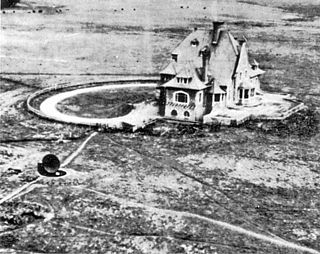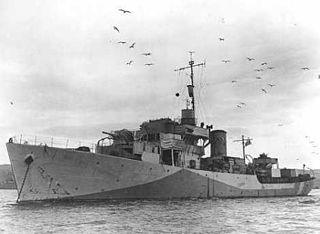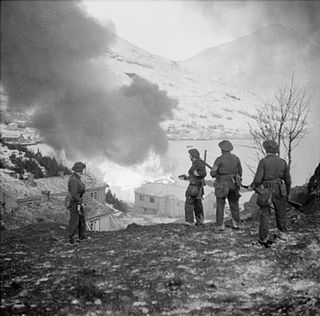| Operation Candytuft | |||||||
|---|---|---|---|---|---|---|---|
| Part of World War II | |||||||
| |||||||
| Belligerents | |||||||
| Casualties and losses | |||||||
| Two captured | |||||||
During World War II, Operation Candytuft was a British raid by 2nd Special Air Service launched on 27 October 1943.
| Operation Candytuft | |||||||
|---|---|---|---|---|---|---|---|
| Part of World War II | |||||||
| |||||||
| Belligerents | |||||||
| Casualties and losses | |||||||
| Two captured | |||||||
During World War II, Operation Candytuft was a British raid by 2nd Special Air Service launched on 27 October 1943.
Inserted by boat on Italy’s east coast between Ancona and Pescara, the troopers were to destroy railway bridges and disrupt rear areas. The raid was conducted by No. 3 Commando and 6 Demolition Corps under the command of Major Terence Otway. They were dropped as planned at Naine, a small village 10 miles north of the objectives. A fire fight broke out in the village due to the unexpected presence of the 153 grenadiers who were transferred from the Gustav line three days earlier. In order to replenish his supplies Major Ottoway retreated south to Malconi where he and his team were surrounded by the Wehrmacht and later surrendered.

The Qibya massacre occurred during Operation Shoshana, a reprisal operation that occurred in October 1953 when Israeli troops under Ariel Sharon attacked the village of Qibya in the West Bank, which was then under Jordan's control, and killed Palestinian civilians.

The 1st "Golani" Brigade is an Israeli military infantry brigade. It is subordinated to the 36th Division and traditionally associated with the Northern Command. It is one of the five infantry brigades of the regular Israel Defense Forces (IDF), the others being the Paratroopers Brigade, the Nahal Brigade, the Givati Brigade and the Kfir Brigade. Its symbol is a green olive tree against a yellow background, with its soldiers wearing a brown beret. It is one of the most highly decorated infantry units in the IDF. The brigade consists of five battalions, including two which it kept from its inception, one transferred from the Givati Brigade (51st).

The Commandos, also known as the British Commandos, were formed during the Second World War in June 1940, following a request from Winston Churchill, for special forces that could carry out raids against German-occupied Europe. Initially drawn from within the British Army from soldiers who volunteered for the Special Service Brigade, the Commandos' ranks would eventually be filled by members of all branches of the British Armed Forces and a number of foreign volunteers from German-occupied countries. By the end of the war 25,000 men had passed through the Commando course at Achnacarry. This total includes not only the British volunteers, but volunteers from Greece, France, Belgium, Netherlands, Canada, Norway, Poland, and the United States Army Rangers and US Marine Corps Raiders, Portuguese Fuzileiros Portuguese Marine Corps were modelled on the Commandos.

Operation Jubilee or the Dieppe Raid was an Allied amphibious attack on the German-occupied port of Dieppe in northern France, during the Second World War. Over 6,050 infantry, predominantly Canadian, supported by a regiment of tanks, were put ashore from a naval force operating under protection of Royal Air Force (RAF) fighters.

Operation Biting, also known as the Bruneval Raid, was a British Combined Operations raid on a German coastal radar installation at Bruneval in northern France, during the Second World War, on the night of 27–28 February 1942.

Iberis, commonly called candytuft, is a genus of flowering plants belonging to the family Brassicaceae. It comprises annuals, evergreen perennials and subshrubs native to the Old World. The name "candytuft" is not related to candy, but derives from Candia, the former name of Iraklion on the Island of Crete.

Operation Blackcock was an operation to clear German troops from the Roer Triangle, formed by the towns of Roermond and Sittard in the Netherlands and Heinsberg in Germany during the fighting on the Western Front in the Second World War. It was conducted by the British Second Army between 13 and 26 January 1945. The objective was to drive the German 15th Army back across the rivers Roer and Wurm and move the frontline further into Germany. The operation was carried out by Lieutenant-General Neil Ritchie's XII Corps by three divisions: the 7th Armoured Division, the 43rd (Wessex) Infantry Division and the 52nd (Lowland) Infantry Division. The operation, named after the Scottish male black grouse, is relatively unknown.
During World War II, Operation Saxifrage was a raid by four small Special Air Service teams who landed on the east coast of Italy on the night of 27 October 1943.

HMCS Long Branch was a modified Flower-class corvette that served in the Royal Canadian Navy during the Second World War. She was used primarily as a convoy escort in the Battle of the Atlantic. She was laid down as HMS Candytuft but was transferred to the RCN on 5 January 1944 before completion. She was named for Long Branch, Ontario, a village that was eventually amalgamated into Toronto, Ontario.

Raiding, also known as depredation, is a military tactic or operational warfare "smash and grab" mission which has a specific purpose. Raiders do not capture and hold a location, but quickly retreat to a previous defended position before enemy forces can respond in a coordinated manner or formulate a counter-attack. Raiders must travel swiftly and are generally too lightly equipped and supported to be able to hold ground. A raiding group may consist of combatants specially trained in this tactic, such as commandos, or as a special mission assigned to any regular troops. Raids are often a standard tactic in irregular warfare, employed by warriors, guerrilla fighters or other irregular military forces. Some raids are large, for example the Sullivan Expedition.

The northern theater of the American Revolutionary War after Saratoga consisted of a series of battles between American revolutionaries and British forces, from 1778 to 1782 during the American Revolutionary War. It is characterized by two primary areas of activity. The first set of activities was based around the British base of operations in New York City, where each side made probes and counterprobes against the other's positions that sometimes resulted in notable actions. The second was essentially a frontier war in Upstate New York and rural northern Pennsylvania that was largely fought by state militia companies and some Indian allies on the American side, and Loyalist companies supported by Indians, British Indian agents, and occasionally British regulars. The notable exception to significant Continental Army participation on the frontier was the 1779 Sullivan Expedition, in which General John Sullivan led an army expedition that drove the Iroquois out of New York. The warfare amongst the splinters of the Iroquois Six Nations were particularly brutal, turning much of the Indian population into refugees.

Iberis gibraltarica, the Gibraltar candytuft, is a flowering plant of the genus Iberis and the family Brassicaceae. It is the symbol of the Upper Rock Nature Reserve in Gibraltar, but is a native of North Africa. Gibraltar is the only place in Europe where it is found growing in the wild. The candytuft grows from crevices in the limestone, and is often seen growing in abundance from the north face of the Rock of Gibraltar. Its flowers range from pale violet to almost white, and can reach up to 8 cm (3.1 in) across.

Chérisy is a commune in the Pas-de-Calais department in the Hauts-de-France region of France.
The Fight at Aldie was a small cavalry skirmish between Confederate forces under Major John S. Mosby and Union forces under Major Joseph Gilmore and Captain Franklin T. Huntoon in Aldie, Virginia, on March 2, 1863, as part of Mosby's Operations in Northern Virginia during the American Civil War. The fight which resulted in a Confederate victory was significant in that it was the first action of Mosby's Rangers within their operating territory in the central Loudoun Valley. In the fight Mosby and his men displayed many characteristics that would become their hallmark including the attack on numerically superior force while inflicting disproportionate casualties to those received.

Special forces or special operations forces (SOF) are military units trained to conduct special operations. NATO has defined special operations as "military activities conducted by specially designated, organized, selected, trained and equipped forces using unconventional techniques and modes of employment".
Saleh al-Somali, born Abdirizaq Abdi Saleh, was described as being an al-Qaeda leader and the group's head of external operations. He was killed by a missile fired from an unmanned predator drone on December 8, 2009. The missile strike was on a suspect compound in Janikhel village near Pakistan's Federally Administered Tribal Areas, today a part of the Khyber Pakhtunkhwa.

Reprisal operations were raids carried out by the Israel Defense Forces in the 1950s and 1960s in response to frequent fedayeen attacks during which armed Arab militants infiltrated Israel from Syria, Egypt, and Jordan to carry out attacks on Israeli civilians and soldiers. Most of the reprisal operations followed raids that resulted in Israeli fatalities. The goal of these operations – from the perspective of Israeli officials – was to create deterrence and prevent future attacks. Two other factors behind the raids were restoring public morale and training newly formed army units. A number of these operations involved attacking villages and Palestinian civilians in the West Bank, including the 1953 Qibya massacre.

The Japanese occupation of Attu was the result of an invasion of the Aleutian Islands in Alaska during World War II. Imperial Japanese Army troops landed on 7 June 1942, the day after the invasion of nearby Kiska. Along with the Kiska landing, it was the first time that the continental United States was invaded and occupied by a foreign power since the War of 1812, and was the second of the only two invasions of the United States during World War II. The occupation ended with the Allied victory in the Battle of Attu on 30 May 1943.

The Raid on Santorini took place on 24 April 1944 as part of the Mediterranean Campaign in World War II. It was conducted by the British Special Boat Service, against the mixed German and Italian garrison on the island of Santorini (Thera) in the Aegean Sea. The raid was made in tandem with similar operations at the islands of Ios, Mykonos and Amorgos that aimed to destroy Axis naval observation posts and radio stations on the Cycladic islands.

On 26–27 October 2019, the United States conducted a military operation code named Operation Kayla Mueller that resulted in the death of Abu Bakr al-Baghdadi, the then-leader and self-proclaimed caliph of the Islamic State (IS) terrorist organization. The operation took place in the outskirts of Barisha, Idlib Governorate, Syria. According to General Kenneth F. McKenzie Jr., the United States Central Command (CENTCOM) commander who oversaw the operation, Baghdadi killed himself along with two children when he detonated a suicide belt while seeking to evade U.S. forces during the raid.